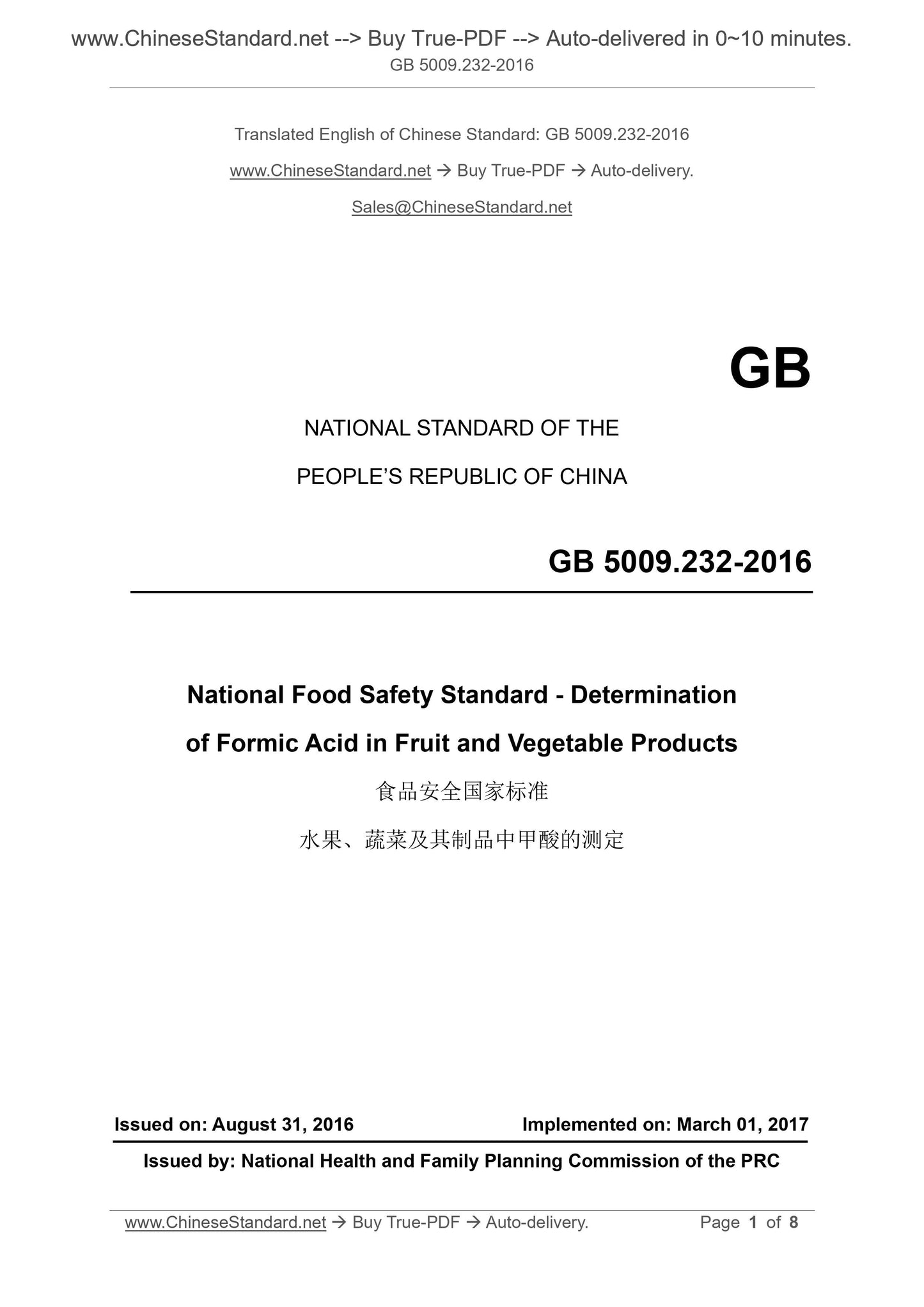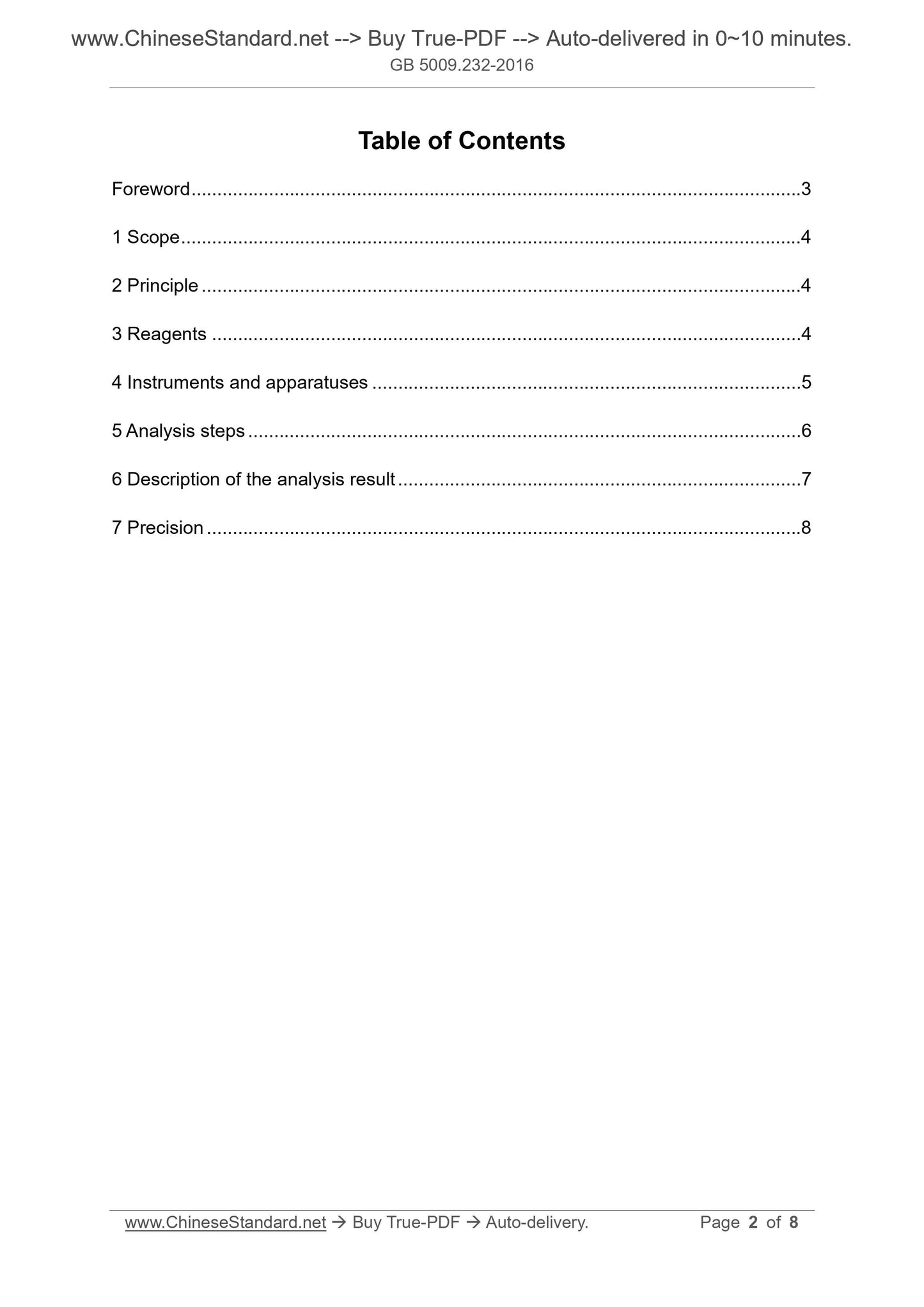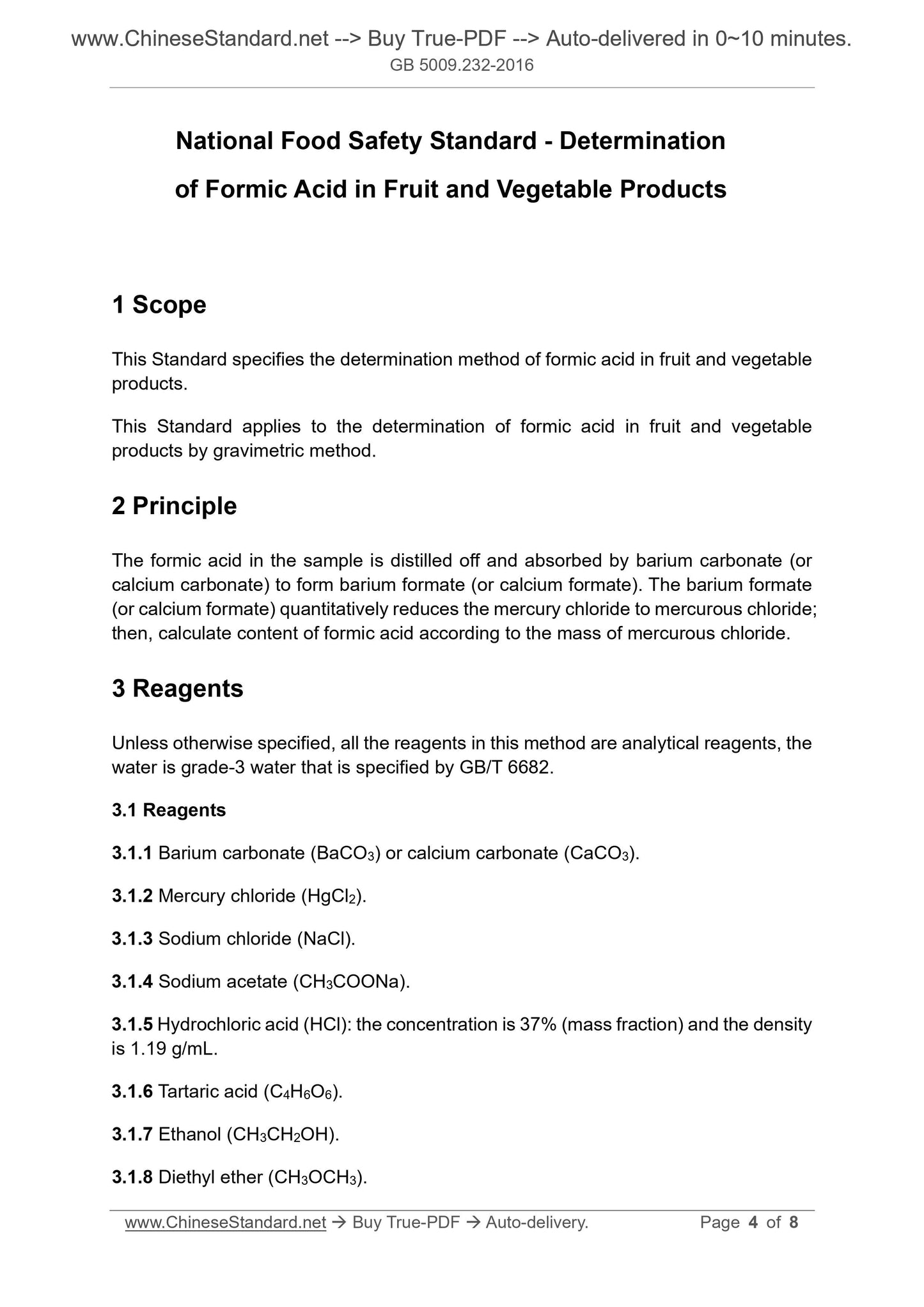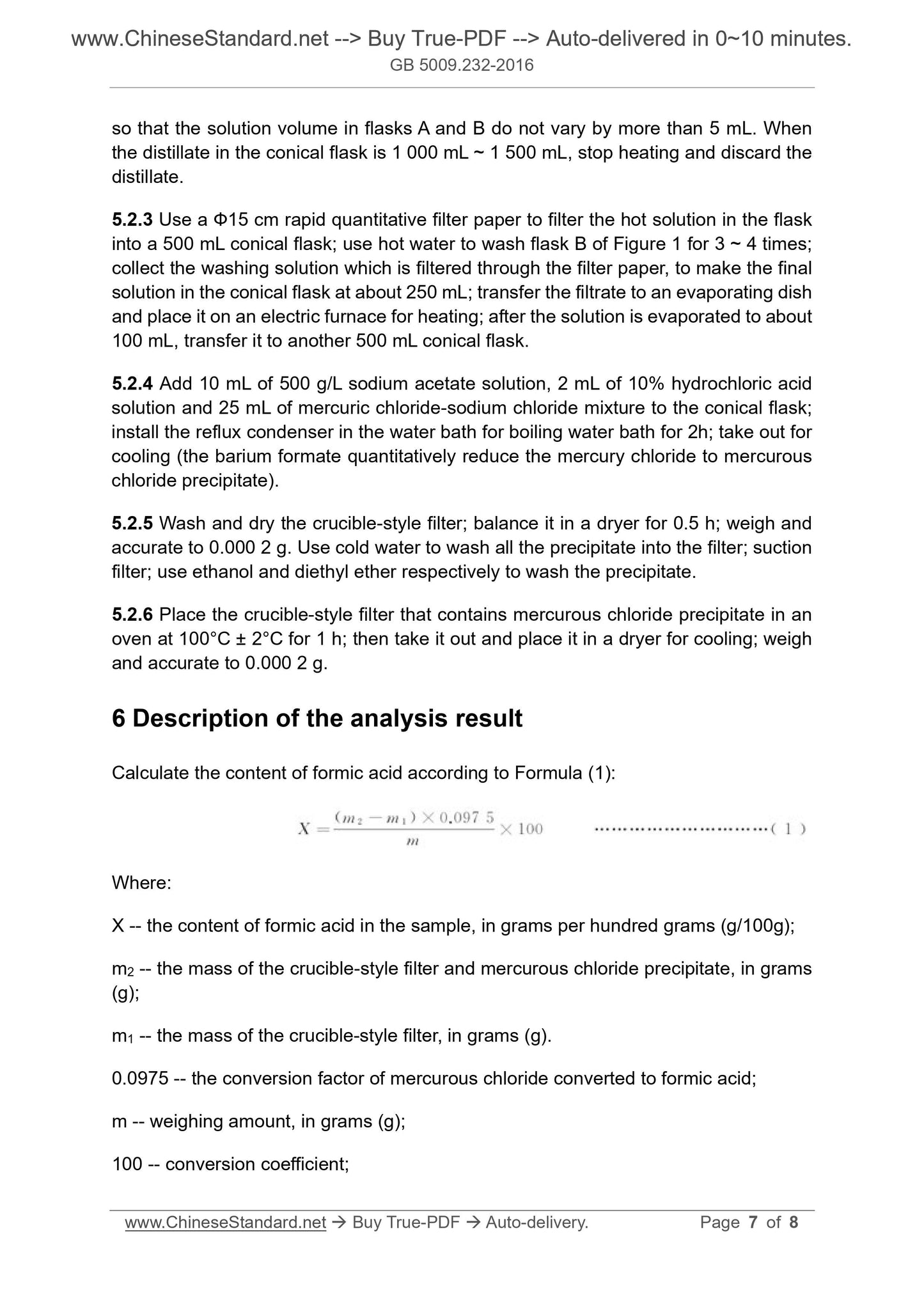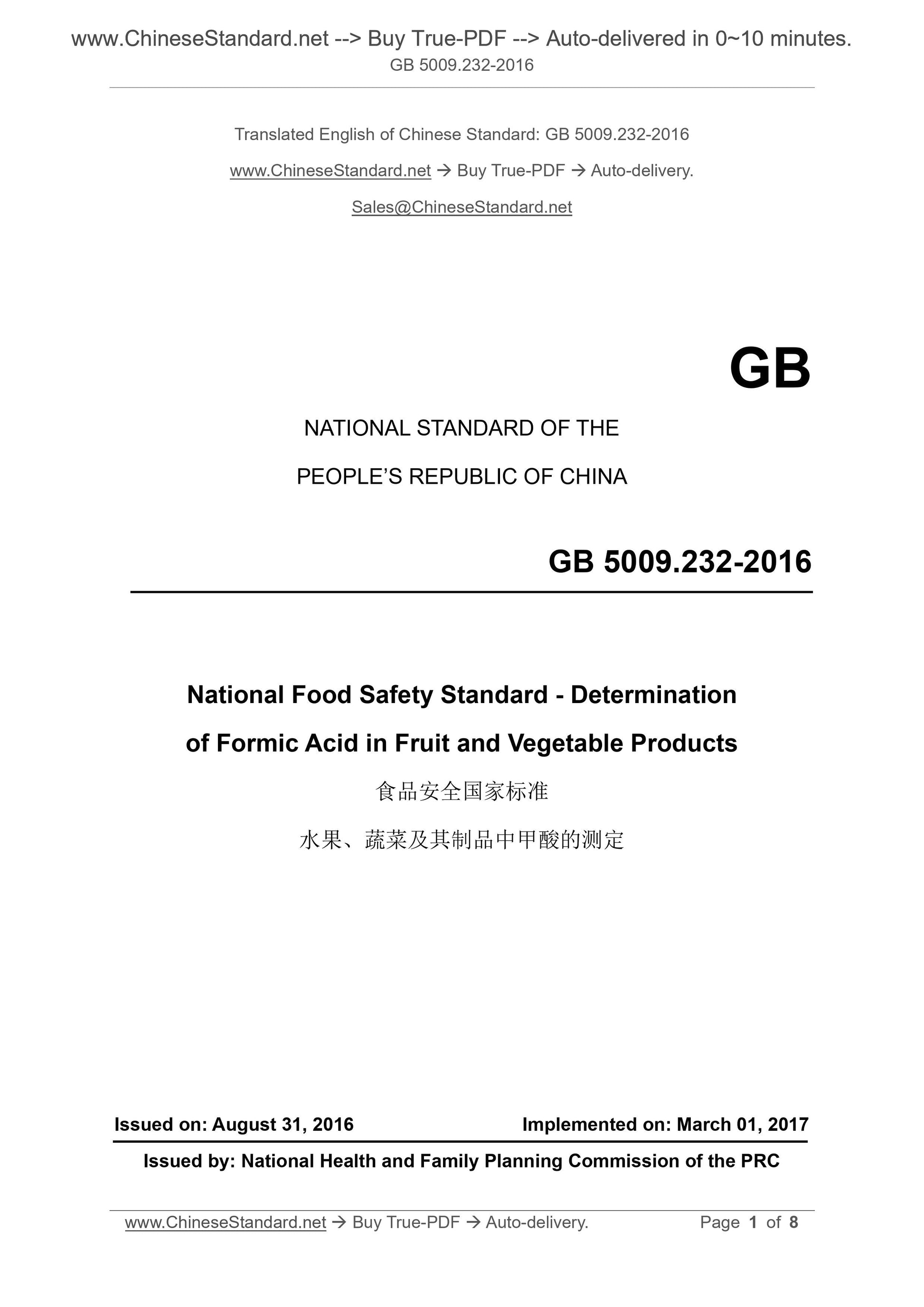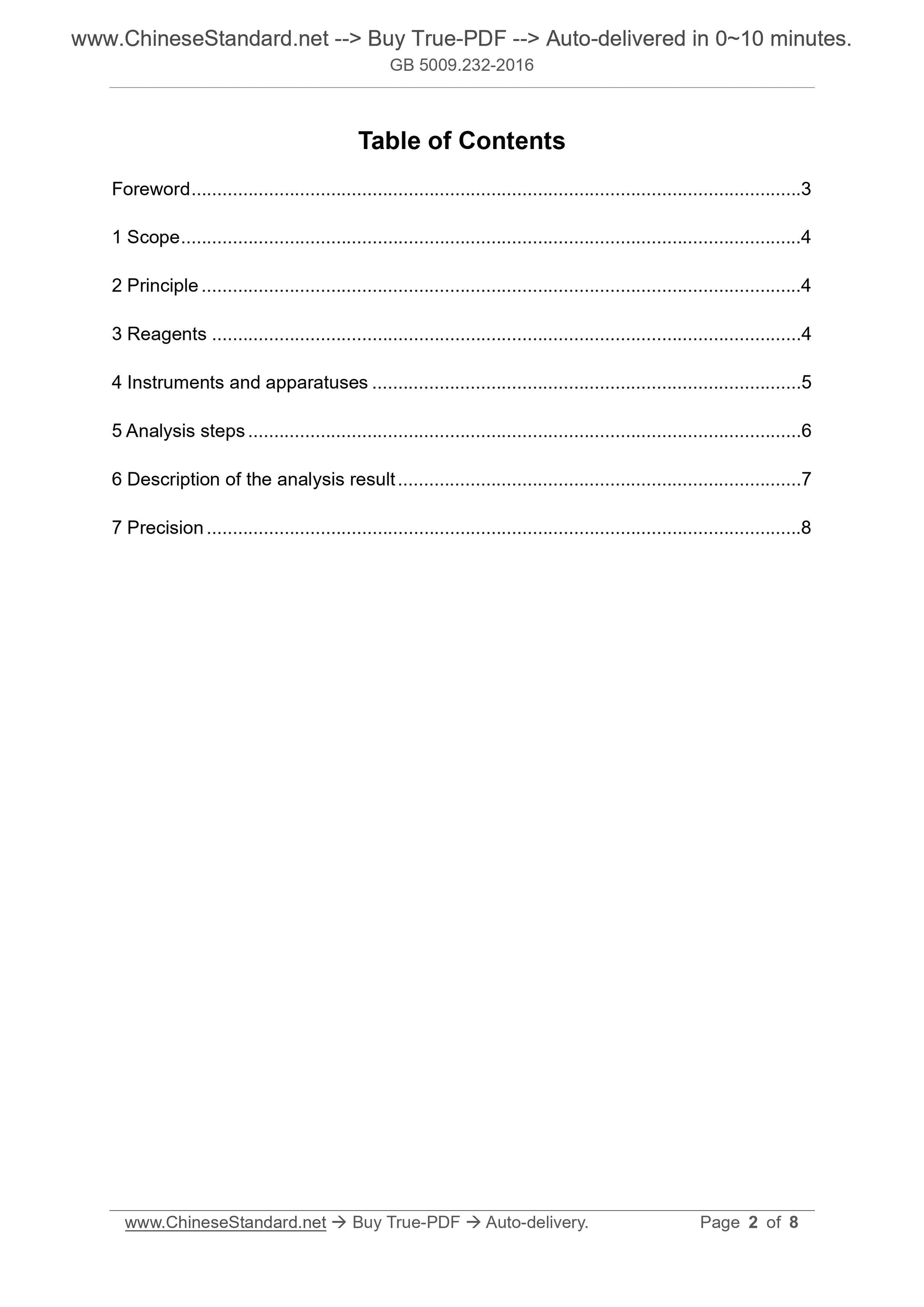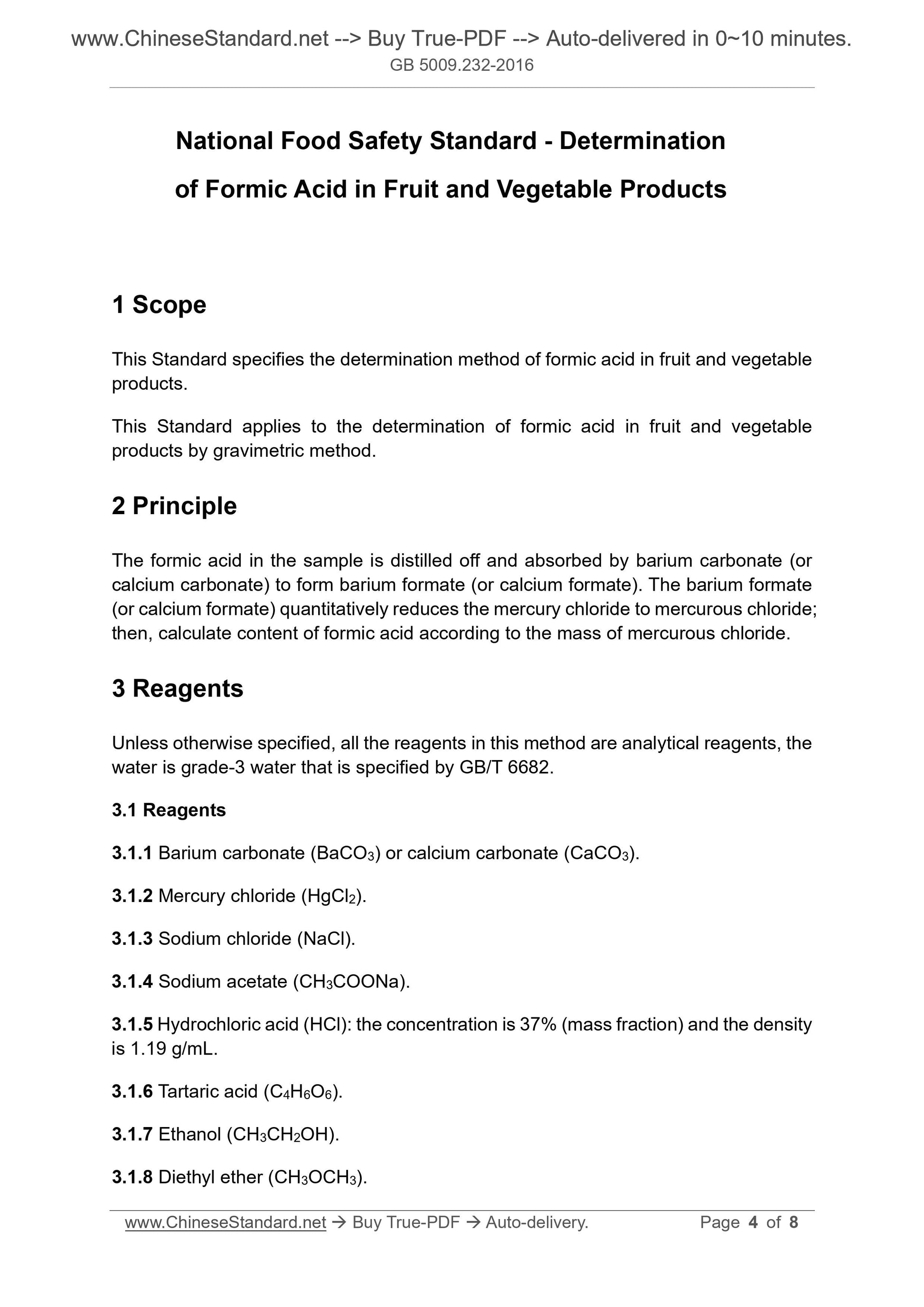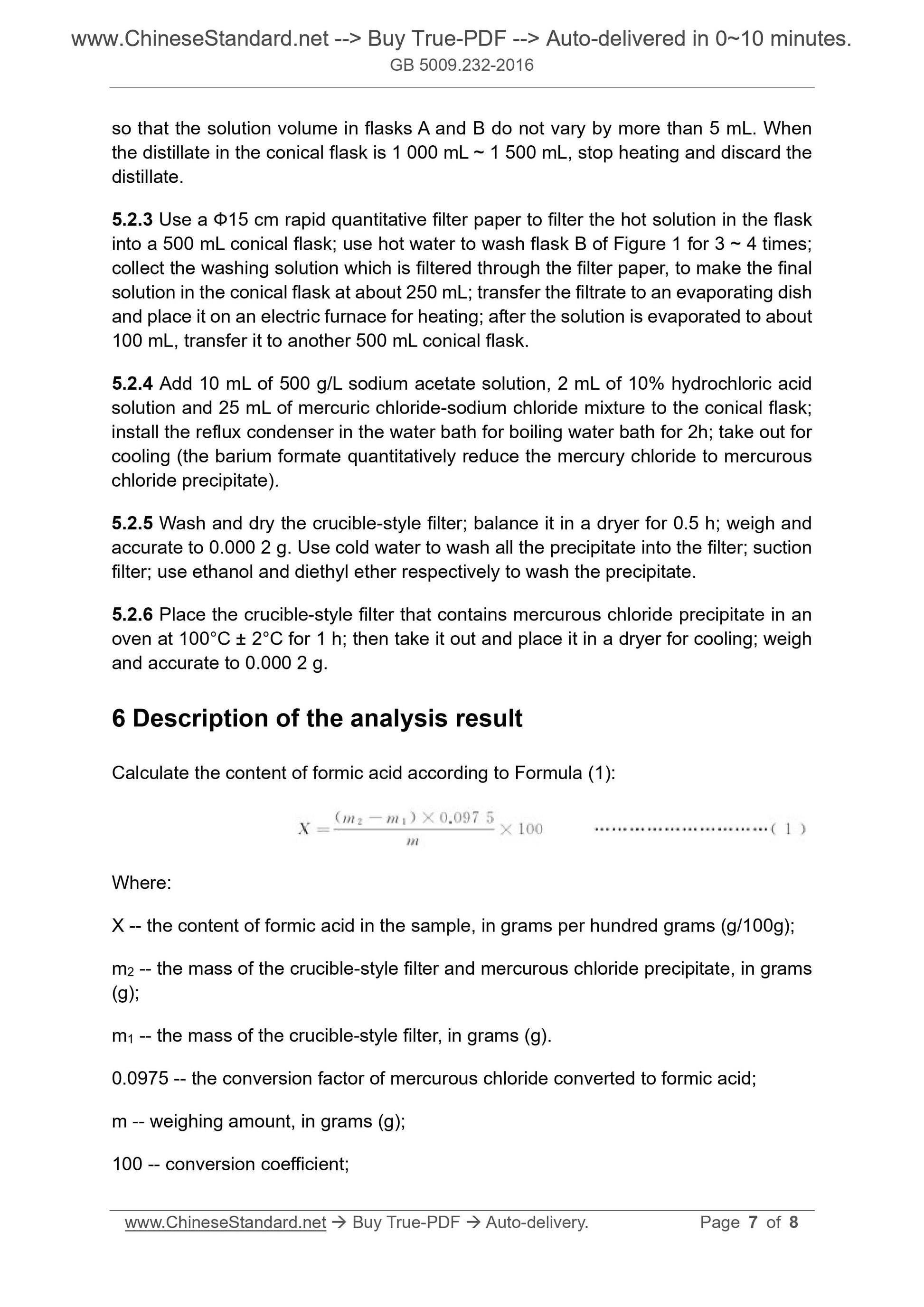1
/
of
4
www.ChineseStandard.us -- Field Test Asia Pte. Ltd.
GB 5009.232-2016 English PDF
GB 5009.232-2016 English PDF
Regular price
$70.00
Regular price
Sale price
$70.00
Unit price
/
per
Shipping calculated at checkout.
Couldn't load pickup availability
GB 5009.232-2016: Fruit and vegetable products -- Determination of formic acid content -- Gravimetric method
Delivery: 9 seconds. Download (& Email) true-PDF + Invoice.
Get Quotation: Click GB 5009.232-2016 (Self-service in 1-minute)
Historical versions (Master-website): GB 5009.232-2016
Preview True-PDF (Reload/Scroll-down if blank)
GB 5009.232-2016
GB
NATIONAL STANDARD OF THE
PEOPLE’S REPUBLIC OF CHINA
National Food Safety Standard - Determination
of Formic Acid in Fruit and Vegetable Products
ISSUED ON: AUGUST 31, 2016
IMPLEMENTED ON: MARCH 01, 2017
Issued by: National Health and Family Planning Commission of the PRC
Table of Contents
Foreword ...3
1 Scope ...4
2 Principle ...4
3 Reagents ...4
4 Instruments and apparatuses ...5
5 Analysis steps ...6
6 Description of the analysis result ...7
7 Precision ...8
National Food Safety Standard - Determination
of Formic Acid in Fruit and Vegetable Products
1 Scope
This Standard specifies the determination method of formic acid in fruit and vegetable
products.
This Standard applies to the determination of formic acid in fruit and vegetable
products by gravimetric method.
2 Principle
The formic acid in the sample is distilled off and absorbed by barium carbonate (or
calcium carbonate) to form barium formate (or calcium formate). The barium formate
(or calcium formate) quantitatively reduces the mercury chloride to mercurous chloride;
then, calculate content of formic acid according to the mass of mercurous chloride.
3 Reagents
Unless otherwise specified, all the reagents in this method are analytical reagents, the
water is grade-3 water that is specified by GB/T 6682.
3.1 Reagents
3.1.1 Barium carbonate (BaCO3) or calcium carbonate (CaCO3).
3.1.2 Mercury chloride (HgCl2).
3.1.3 Sodium chloride (NaCl).
3.1.4 Sodium acetate (CH3COONa).
3.1.5 Hydrochloric acid (HCl): the concentration is 37% (mass fraction) and the density
is 1.19 g/mL.
3.1.6 Tartaric acid (C4H6O6).
3.1.7 Ethanol (CH3CH2OH).
3.1.8 Diethyl ether (CH3OCH3).
so that the solution volume in flasks A and B do not vary by more than 5 mL. When
the distillate in the conical flask is 1 000 mL ~ 1 500 mL, stop heating and discard the
distillate.
5.2.3 Use a Ф15 cm rapid quantitative filter paper to filter the hot solution in the flask
into a 500 mL conical flask; use hot water to wash flask B of Figure 1 for 3 ~ 4 times;
collect the washing solution which is filtered through the filter paper, to make the final
solution in the conical flask at about 250 mL; transfer the filtrate to an evaporating dish
and place it on an electric furnace for heating; after the solution is evaporated to about
100 mL, transfer it to another 500 mL conical flask.
5.2.4 Add 10 mL of 500 g/L sodium acetate solution, 2 mL of 10% hydrochloric acid
solution and 25 mL of mercuric chloride-sodium chloride mixture to the conical flask;
install the reflux condenser in the water bath for boiling water bath for 2h; take out for
cooling (the barium formate quantitatively reduce the mercury chloride to mercurous
chloride precipitate).
5.2.5 Wash and dry the crucible-style filter; balance it in a dryer for 0.5 h; weigh and
accurate to 0.000 2 g. Use cold water to wash all the precipitate into the filter; suction
filter; use ethanol and diethyl ether respectively to wash the precipitate.
5.2.6 Place the crucible-style filter that contains mercurous chloride precipitate in an
oven at 100°C ± 2°C for 1 h; then take it out and place it in a dryer for cooling; weigh
and accurate to 0.000 2 g.
6 Description of the analysis result
Calculate the content of formic acid according to Formula (1):
Where:
X -- the content of formic acid in the sample, in grams per hundred grams (g/100g);
m2 -- the mass of the crucible-style filter and mercurous chloride precipitate, in grams
(g);
m1 -- the mass of the crucible-style filter, in grams (g).
0.0975 -- the conversion factor of mercurous chloride converted to formic acid;
m -- weighing amount, in grams (g);
100 -- conversion coefficient;
GB 5009.232-2016
GB
NATIONAL STANDARD OF THE
PEOPLE’S REPUBLIC OF CHINA
National Food Safety Standard - Determination
of Formic Acid in Fruit and Vegetable Products
ISSUED ON: AUGUST 31, 2016
IMPLEMENTED ON: MARCH 01, 2017
Issued by: National Health and Family Planning Commission of the PRC
Table of Contents
Foreword ...3
1 Scope ...4
2 Principle ...4
3 Reagents ...4
4 Instruments and apparatuses ...5
5 Analysis steps ...6
6 Description of the analysis result ...7
7 Precision ...8
National Food Safety Standard - Determination
of Formic Acid in Fruit and Vegetable Products
1 Scope
This Standard specifies the determination method of formic acid in fruit and vegetable
products.
This Standard applies to the determination of formic acid in fruit and vegetable
products by gravimetric method.
2 Principle
The formic acid in the sample is distilled off and absorbed by barium carbonate (or
calcium carbonate) to form barium formate (or calcium formate). The barium formate
(or calcium formate) quantitatively reduces the mercury chloride to mercurous chloride;
then, calculate content of formic acid according to the mass of mercurous chloride.
3 Reagents
Unless otherwise specified, all the reagents in this method are analytical reagents, the
water is grade-3 water that is specified by GB/T 6682.
3.1 Reagents
3.1.1 Barium carbonate (BaCO3) or calcium carbonate (CaCO3).
3.1.2 Mercury chloride (HgCl2).
3.1.3 Sodium chloride (NaCl).
3.1.4 Sodium acetate (CH3COONa).
3.1.5 Hydrochloric acid (HCl): the concentration is 37% (mass fraction) and the density
is 1.19 g/mL.
3.1.6 Tartaric acid (C4H6O6).
3.1.7 Ethanol (CH3CH2OH).
3.1.8 Diethyl ether (CH3OCH3).
so that the solution volume in flasks A and B do not vary by more than 5 mL. When
the distillate in the conical flask is 1 000 mL ~ 1 500 mL, stop heating and discard the
distillate.
5.2.3 Use a Ф15 cm rapid quantitative filter paper to filter the hot solution in the flask
into a 500 mL conical flask; use hot water to wash flask B of Figure 1 for 3 ~ 4 times;
collect the washing solution which is filtered through the filter paper, to make the final
solution in the conical flask at about 250 mL; transfer the filtrate to an evaporating dish
and place it on an electric furnace for heating; after the solution is evaporated to about
100 mL, transfer it to another 500 mL conical flask.
5.2.4 Add 10 mL of 500 g/L sodium acetate solution, 2 mL of 10% hydrochloric acid
solution and 25 mL of mercuric chloride-sodium chloride mixture to the conical flask;
install the reflux condenser in the water bath for boiling water bath for 2h; take out for
cooling (the barium formate quantitatively reduce the mercury chloride to mercurous
chloride precipitate).
5.2.5 Wash and dry the crucible-style filter; balance it in a dryer for 0.5 h; weigh and
accurate to 0.000 2 g. Use cold water to wash all the precipitate into the filter; suction
filter; use ethanol and diethyl ether respectively to wash the precipitate.
5.2.6 Place the crucible-style filter that contains mercurous chloride precipitate in an
oven at 100°C ± 2°C for 1 h; then take it out and place it in a dryer for cooling; weigh
and accurate to 0.000 2 g.
6 Description of the analysis result
Calculate the content of formic acid according to Formula (1):
Where:
X -- the content of formic acid in the sample, in grams per hundred grams (g/100g);
m2 -- the mass of the crucible-style filter and mercurous chloride precipitate, in grams
(g);
m1 -- the mass of the crucible-style filter, in grams (g).
0.0975 -- the conversion factor of mercurous chloride converted to formic acid;
m -- weighing amount, in grams (g);
100 -- conversion coefficient;
Delivery: 9 seconds. Download (& Email) true-PDF + Invoice.
Get Quotation: Click GB 5009.232-2016 (Self-service in 1-minute)
Historical versions (Master-website): GB 5009.232-2016
Preview True-PDF (Reload/Scroll-down if blank)
GB 5009.232-2016
GB
NATIONAL STANDARD OF THE
PEOPLE’S REPUBLIC OF CHINA
National Food Safety Standard - Determination
of Formic Acid in Fruit and Vegetable Products
ISSUED ON: AUGUST 31, 2016
IMPLEMENTED ON: MARCH 01, 2017
Issued by: National Health and Family Planning Commission of the PRC
Table of Contents
Foreword ...3
1 Scope ...4
2 Principle ...4
3 Reagents ...4
4 Instruments and apparatuses ...5
5 Analysis steps ...6
6 Description of the analysis result ...7
7 Precision ...8
National Food Safety Standard - Determination
of Formic Acid in Fruit and Vegetable Products
1 Scope
This Standard specifies the determination method of formic acid in fruit and vegetable
products.
This Standard applies to the determination of formic acid in fruit and vegetable
products by gravimetric method.
2 Principle
The formic acid in the sample is distilled off and absorbed by barium carbonate (or
calcium carbonate) to form barium formate (or calcium formate). The barium formate
(or calcium formate) quantitatively reduces the mercury chloride to mercurous chloride;
then, calculate content of formic acid according to the mass of mercurous chloride.
3 Reagents
Unless otherwise specified, all the reagents in this method are analytical reagents, the
water is grade-3 water that is specified by GB/T 6682.
3.1 Reagents
3.1.1 Barium carbonate (BaCO3) or calcium carbonate (CaCO3).
3.1.2 Mercury chloride (HgCl2).
3.1.3 Sodium chloride (NaCl).
3.1.4 Sodium acetate (CH3COONa).
3.1.5 Hydrochloric acid (HCl): the concentration is 37% (mass fraction) and the density
is 1.19 g/mL.
3.1.6 Tartaric acid (C4H6O6).
3.1.7 Ethanol (CH3CH2OH).
3.1.8 Diethyl ether (CH3OCH3).
so that the solution volume in flasks A and B do not vary by more than 5 mL. When
the distillate in the conical flask is 1 000 mL ~ 1 500 mL, stop heating and discard the
distillate.
5.2.3 Use a Ф15 cm rapid quantitative filter paper to filter the hot solution in the flask
into a 500 mL conical flask; use hot water to wash flask B of Figure 1 for 3 ~ 4 times;
collect the washing solution which is filtered through the filter paper, to make the final
solution in the conical flask at about 250 mL; transfer the filtrate to an evaporating dish
and place it on an electric furnace for heating; after the solution is evaporated to about
100 mL, transfer it to another 500 mL conical flask.
5.2.4 Add 10 mL of 500 g/L sodium acetate solution, 2 mL of 10% hydrochloric acid
solution and 25 mL of mercuric chloride-sodium chloride mixture to the conical flask;
install the reflux condenser in the water bath for boiling water bath for 2h; take out for
cooling (the barium formate quantitatively reduce the mercury chloride to mercurous
chloride precipitate).
5.2.5 Wash and dry the crucible-style filter; balance it in a dryer for 0.5 h; weigh and
accurate to 0.000 2 g. Use cold water to wash all the precipitate into the filter; suction
filter; use ethanol and diethyl ether respectively to wash the precipitate.
5.2.6 Place the crucible-style filter that contains mercurous chloride precipitate in an
oven at 100°C ± 2°C for 1 h; then take it out and place it in a dryer for cooling; weigh
and accurate to 0.000 2 g.
6 Description of the analysis result
Calculate the content of formic acid according to Formula (1):
Where:
X -- the content of formic acid in the sample, in grams per hundred grams (g/100g);
m2 -- the mass of the crucible-style filter and mercurous chloride precipitate, in grams
(g);
m1 -- the mass of the crucible-style filter, in grams (g).
0.0975 -- the conversion factor of mercurous chloride converted to formic acid;
m -- weighing amount, in grams (g);
100 -- conversion coefficient;
GB 5009.232-2016
GB
NATIONAL STANDARD OF THE
PEOPLE’S REPUBLIC OF CHINA
National Food Safety Standard - Determination
of Formic Acid in Fruit and Vegetable Products
ISSUED ON: AUGUST 31, 2016
IMPLEMENTED ON: MARCH 01, 2017
Issued by: National Health and Family Planning Commission of the PRC
Table of Contents
Foreword ...3
1 Scope ...4
2 Principle ...4
3 Reagents ...4
4 Instruments and apparatuses ...5
5 Analysis steps ...6
6 Description of the analysis result ...7
7 Precision ...8
National Food Safety Standard - Determination
of Formic Acid in Fruit and Vegetable Products
1 Scope
This Standard specifies the determination method of formic acid in fruit and vegetable
products.
This Standard applies to the determination of formic acid in fruit and vegetable
products by gravimetric method.
2 Principle
The formic acid in the sample is distilled off and absorbed by barium carbonate (or
calcium carbonate) to form barium formate (or calcium formate). The barium formate
(or calcium formate) quantitatively reduces the mercury chloride to mercurous chloride;
then, calculate content of formic acid according to the mass of mercurous chloride.
3 Reagents
Unless otherwise specified, all the reagents in this method are analytical reagents, the
water is grade-3 water that is specified by GB/T 6682.
3.1 Reagents
3.1.1 Barium carbonate (BaCO3) or calcium carbonate (CaCO3).
3.1.2 Mercury chloride (HgCl2).
3.1.3 Sodium chloride (NaCl).
3.1.4 Sodium acetate (CH3COONa).
3.1.5 Hydrochloric acid (HCl): the concentration is 37% (mass fraction) and the density
is 1.19 g/mL.
3.1.6 Tartaric acid (C4H6O6).
3.1.7 Ethanol (CH3CH2OH).
3.1.8 Diethyl ether (CH3OCH3).
so that the solution volume in flasks A and B do not vary by more than 5 mL. When
the distillate in the conical flask is 1 000 mL ~ 1 500 mL, stop heating and discard the
distillate.
5.2.3 Use a Ф15 cm rapid quantitative filter paper to filter the hot solution in the flask
into a 500 mL conical flask; use hot water to wash flask B of Figure 1 for 3 ~ 4 times;
collect the washing solution which is filtered through the filter paper, to make the final
solution in the conical flask at about 250 mL; transfer the filtrate to an evaporating dish
and place it on an electric furnace for heating; after the solution is evaporated to about
100 mL, transfer it to another 500 mL conical flask.
5.2.4 Add 10 mL of 500 g/L sodium acetate solution, 2 mL of 10% hydrochloric acid
solution and 25 mL of mercuric chloride-sodium chloride mixture to the conical flask;
install the reflux condenser in the water bath for boiling water bath for 2h; take out for
cooling (the barium formate quantitatively reduce the mercury chloride to mercurous
chloride precipitate).
5.2.5 Wash and dry the crucible-style filter; balance it in a dryer for 0.5 h; weigh and
accurate to 0.000 2 g. Use cold water to wash all the precipitate into the filter; suction
filter; use ethanol and diethyl ether respectively to wash the precipitate.
5.2.6 Place the crucible-style filter that contains mercurous chloride precipitate in an
oven at 100°C ± 2°C for 1 h; then take it out and place it in a dryer for cooling; weigh
and accurate to 0.000 2 g.
6 Description of the analysis result
Calculate the content of formic acid according to Formula (1):
Where:
X -- the content of formic acid in the sample, in grams per hundred grams (g/100g);
m2 -- the mass of the crucible-style filter and mercurous chloride precipitate, in grams
(g);
m1 -- the mass of the crucible-style filter, in grams (g).
0.0975 -- the conversion factor of mercurous chloride converted to formic acid;
m -- weighing amount, in grams (g);
100 -- conversion coefficient;
Share
